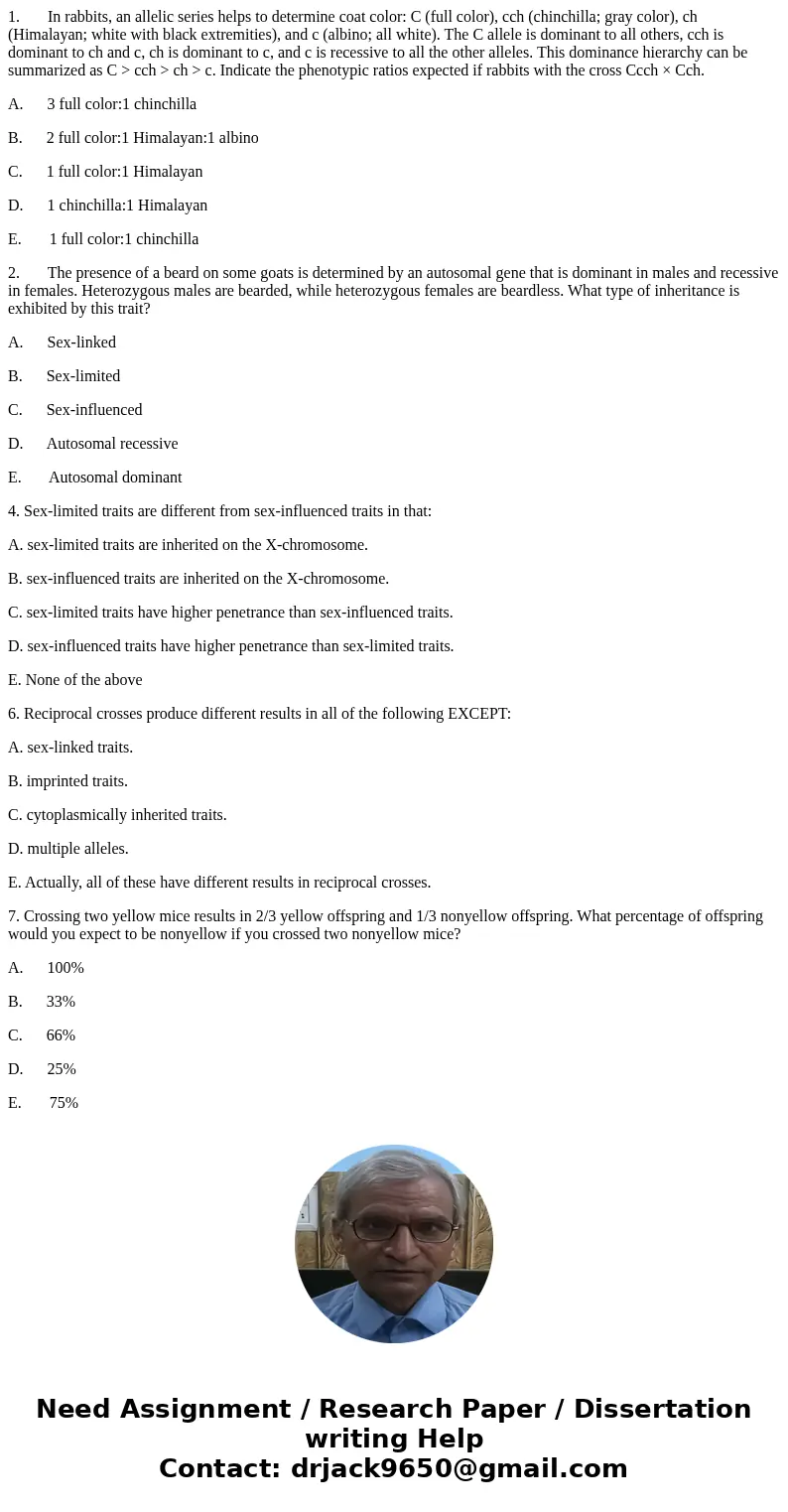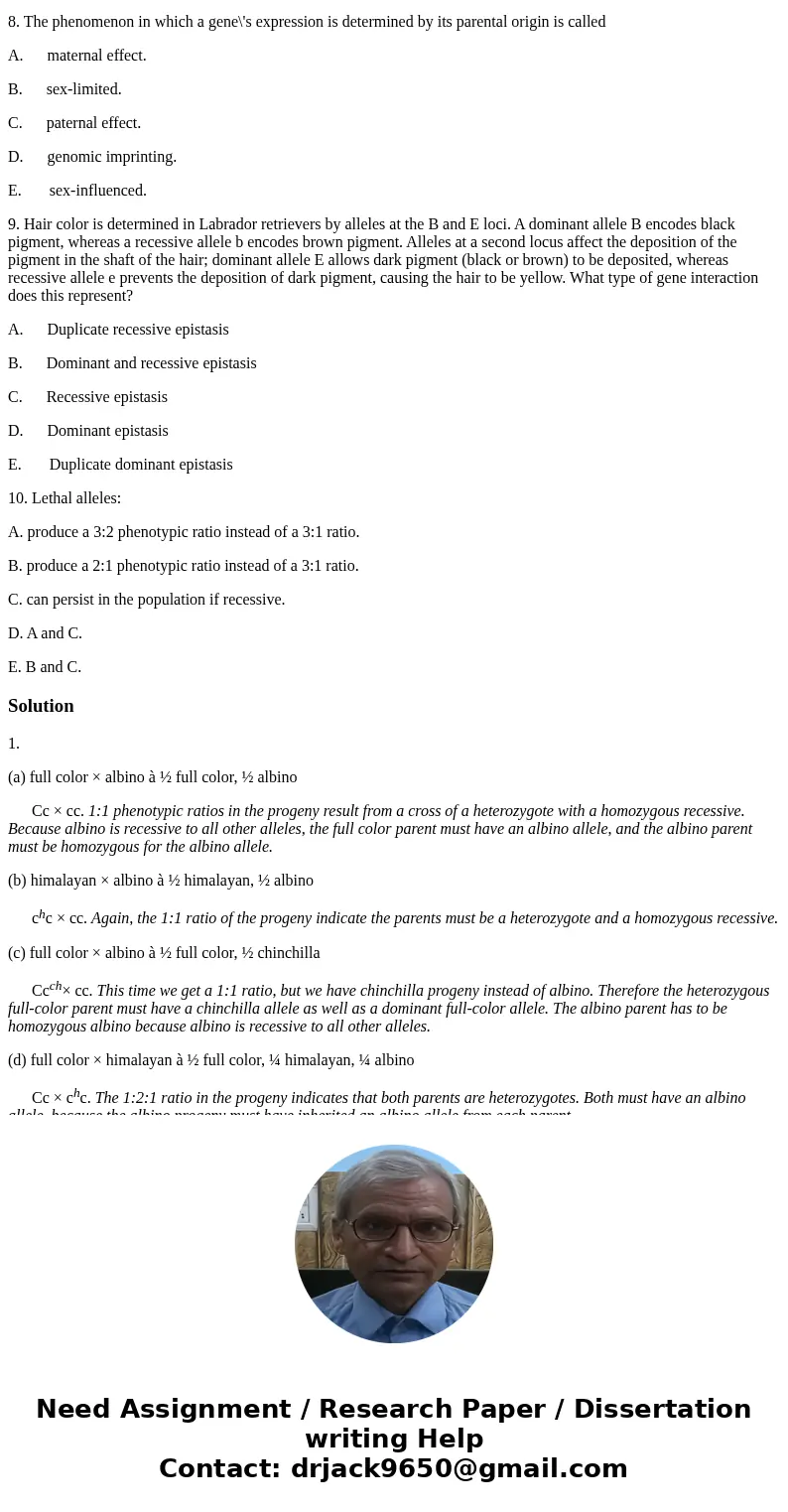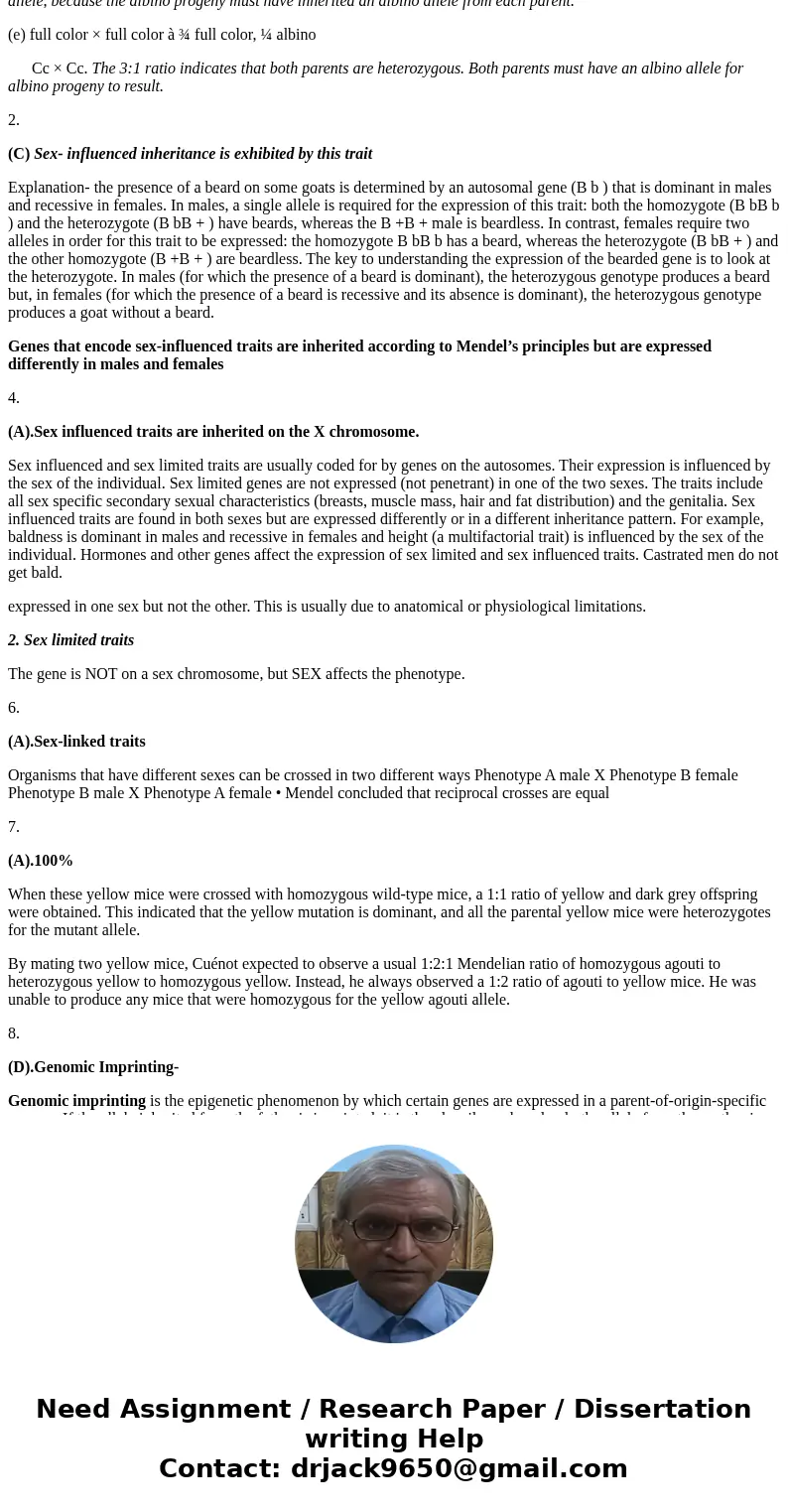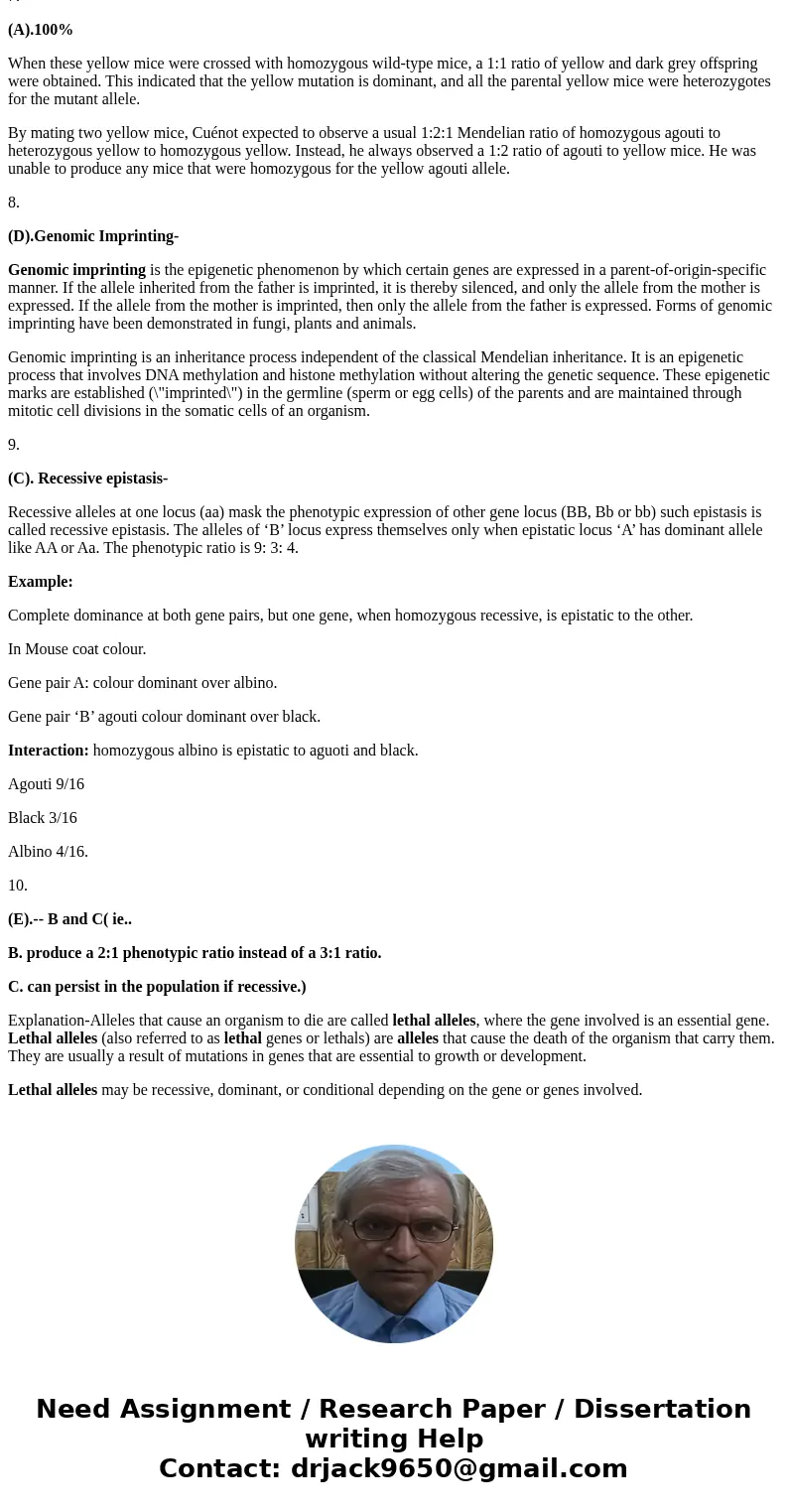1 In rabbits an allelic series helps to determine coat color
1. In rabbits, an allelic series helps to determine coat color: C (full color), cch (chinchilla; gray color), ch (Himalayan; white with black extremities), and c (albino; all white). The C allele is dominant to all others, cch is dominant to ch and c, ch is dominant to c, and c is recessive to all the other alleles. This dominance hierarchy can be summarized as C > cch > ch > c. Indicate the phenotypic ratios expected if rabbits with the cross Ccch × Cch.
A. 3 full color:1 chinchilla
B. 2 full color:1 Himalayan:1 albino
C. 1 full color:1 Himalayan
D. 1 chinchilla:1 Himalayan
E. 1 full color:1 chinchilla
2. The presence of a beard on some goats is determined by an autosomal gene that is dominant in males and recessive in females. Heterozygous males are bearded, while heterozygous females are beardless. What type of inheritance is exhibited by this trait?
A. Sex-linked
B. Sex-limited
C. Sex-influenced
D. Autosomal recessive
E. Autosomal dominant
4. Sex-limited traits are different from sex-influenced traits in that:
A. sex-limited traits are inherited on the X-chromosome.
B. sex-influenced traits are inherited on the X-chromosome.
C. sex-limited traits have higher penetrance than sex-influenced traits.
D. sex-influenced traits have higher penetrance than sex-limited traits.
E. None of the above
6. Reciprocal crosses produce different results in all of the following EXCEPT:
A. sex-linked traits.
B. imprinted traits.
C. cytoplasmically inherited traits.
D. multiple alleles.
E. Actually, all of these have different results in reciprocal crosses.
7. Crossing two yellow mice results in 2/3 yellow offspring and 1/3 nonyellow offspring. What percentage of offspring would you expect to be nonyellow if you crossed two nonyellow mice?
A. 100%
B. 33%
C. 66%
D. 25%
E. 75%
8. The phenomenon in which a gene\'s expression is determined by its parental origin is called
A. maternal effect.
B. sex-limited.
C. paternal effect.
D. genomic imprinting.
E. sex-influenced.
9. Hair color is determined in Labrador retrievers by alleles at the B and E loci. A dominant allele B encodes black pigment, whereas a recessive allele b encodes brown pigment. Alleles at a second locus affect the deposition of the pigment in the shaft of the hair; dominant allele E allows dark pigment (black or brown) to be deposited, whereas recessive allele e prevents the deposition of dark pigment, causing the hair to be yellow. What type of gene interaction does this represent?
A. Duplicate recessive epistasis
B. Dominant and recessive epistasis
C. Recessive epistasis
D. Dominant epistasis
E. Duplicate dominant epistasis
10. Lethal alleles:
A. produce a 3:2 phenotypic ratio instead of a 3:1 ratio.
B. produce a 2:1 phenotypic ratio instead of a 3:1 ratio.
C. can persist in the population if recessive.
D. A and C.
E. B and C.
Solution
1.
(a) full color × albino à ½ full color, ½ albino
Cc × cc. 1:1 phenotypic ratios in the progeny result from a cross of a heterozygote with a homozygous recessive. Because albino is recessive to all other alleles, the full color parent must have an albino allele, and the albino parent must be homozygous for the albino allele.
(b) himalayan × albino à ½ himalayan, ½ albino
chc × cc. Again, the 1:1 ratio of the progeny indicate the parents must be a heterozygote and a homozygous recessive.
(c) full color × albino à ½ full color, ½ chinchilla
Ccch× cc. This time we get a 1:1 ratio, but we have chinchilla progeny instead of albino. Therefore the heterozygous full-color parent must have a chinchilla allele as well as a dominant full-color allele. The albino parent has to be homozygous albino because albino is recessive to all other alleles.
(d) full color × himalayan à ½ full color, ¼ himalayan, ¼ albino
Cc × chc. The 1:2:1 ratio in the progeny indicates that both parents are heterozygotes. Both must have an albino allele, because the albino progeny must have inherited an albino allele from each parent.
(e) full color × full color à ¾ full color, ¼ albino
Cc × Cc. The 3:1 ratio indicates that both parents are heterozygous. Both parents must have an albino allele for albino progeny to result.
2.
(C) Sex- influenced inheritance is exhibited by this trait
Explanation- the presence of a beard on some goats is determined by an autosomal gene (B b ) that is dominant in males and recessive in females. In males, a single allele is required for the expression of this trait: both the homozygote (B bB b ) and the heterozygote (B bB + ) have beards, whereas the B +B + male is beardless. In contrast, females require two alleles in order for this trait to be expressed: the homozygote B bB b has a beard, whereas the heterozygote (B bB + ) and the other homozygote (B +B + ) are beardless. The key to understanding the expression of the bearded gene is to look at the heterozygote. In males (for which the presence of a beard is dominant), the heterozygous genotype produces a beard but, in females (for which the presence of a beard is recessive and its absence is dominant), the heterozygous genotype produces a goat without a beard.
Genes that encode sex-influenced traits are inherited according to Mendel’s principles but are expressed differently in males and females
4.
(A).Sex influenced traits are inherited on the X chromosome.
Sex influenced and sex limited traits are usually coded for by genes on the autosomes. Their expression is influenced by the sex of the individual. Sex limited genes are not expressed (not penetrant) in one of the two sexes. The traits include all sex specific secondary sexual characteristics (breasts, muscle mass, hair and fat distribution) and the genitalia. Sex influenced traits are found in both sexes but are expressed differently or in a different inheritance pattern. For example, baldness is dominant in males and recessive in females and height (a multifactorial trait) is influenced by the sex of the individual. Hormones and other genes affect the expression of sex limited and sex influenced traits. Castrated men do not get bald.
expressed in one sex but not the other. This is usually due to anatomical or physiological limitations.
2. Sex limited traits
The gene is NOT on a sex chromosome, but SEX affects the phenotype.
6.
(A).Sex-linked traits
Organisms that have different sexes can be crossed in two different ways Phenotype A male X Phenotype B female Phenotype B male X Phenotype A female • Mendel concluded that reciprocal crosses are equal
7.
(A).100%
When these yellow mice were crossed with homozygous wild-type mice, a 1:1 ratio of yellow and dark grey offspring were obtained. This indicated that the yellow mutation is dominant, and all the parental yellow mice were heterozygotes for the mutant allele.
By mating two yellow mice, Cuénot expected to observe a usual 1:2:1 Mendelian ratio of homozygous agouti to heterozygous yellow to homozygous yellow. Instead, he always observed a 1:2 ratio of agouti to yellow mice. He was unable to produce any mice that were homozygous for the yellow agouti allele.
8.
(D).Genomic Imprinting-
Genomic imprinting is the epigenetic phenomenon by which certain genes are expressed in a parent-of-origin-specific manner. If the allele inherited from the father is imprinted, it is thereby silenced, and only the allele from the mother is expressed. If the allele from the mother is imprinted, then only the allele from the father is expressed. Forms of genomic imprinting have been demonstrated in fungi, plants and animals.
Genomic imprinting is an inheritance process independent of the classical Mendelian inheritance. It is an epigenetic process that involves DNA methylation and histone methylation without altering the genetic sequence. These epigenetic marks are established (\"imprinted\") in the germline (sperm or egg cells) of the parents and are maintained through mitotic cell divisions in the somatic cells of an organism.
9.
(C). Recessive epistasis-
Recessive alleles at one locus (aa) mask the phenotypic expression of other gene locus (BB, Bb or bb) such epistasis is called recessive epistasis. The alleles of ‘B’ locus express themselves only when epistatic locus ‘A’ has dominant allele like AA or Aa. The phenotypic ratio is 9: 3: 4.
Example:
Complete dominance at both gene pairs, but one gene, when homozygous recessive, is epistatic to the other.
In Mouse coat colour.
Gene pair A: colour dominant over albino.
Gene pair ‘B’ agouti colour dominant over black.
Interaction: homozygous albino is epistatic to aguoti and black.
Agouti 9/16
Black 3/16
Albino 4/16.
10.
(E).-- B and C( ie..
B. produce a 2:1 phenotypic ratio instead of a 3:1 ratio.
C. can persist in the population if recessive.)
Explanation-Alleles that cause an organism to die are called lethal alleles, where the gene involved is an essential gene. Lethal alleles (also referred to as lethal genes or lethals) are alleles that cause the death of the organism that carry them. They are usually a result of mutations in genes that are essential to growth or development.
Lethal alleles may be recessive, dominant, or conditional depending on the gene or genes involved.




 Homework Sourse
Homework Sourse